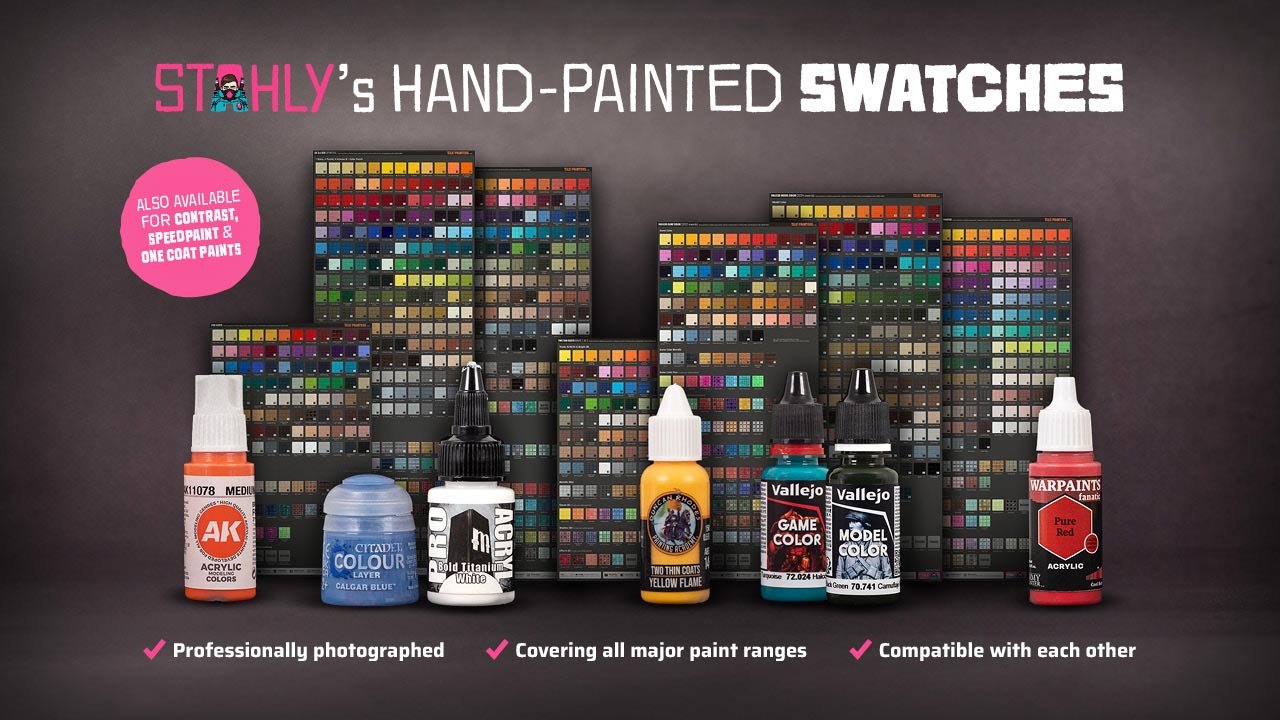In this hobby hack, I’m going to share a few ideas to organise your paint collection by creating a self-made paint swatch. I made one for the 500+ colours I own and it has become an invaluable asset for paint scheme planning and visual referencing. Find out more in this ToP Tip.
The more paints you own, the harder it will become to keep track of your collection, especially if you can’t arrange all your paint pots in sight. Also, dried paints can look noticeably different than wet paint in a pot or bottle, so keeping a hand-painted colour swatch for visual reference is a great idea. Mine has become an invaluable tool to plan my paint schemes, and I also use them to photograph the colour comparisons for our paint reviews.
When I see people make paint swatches, they often use a notebook with plain white (artist) paper. Well, it’s an option, and better than nothing, but paper is open porous and the paint will soak in, resulting in a different finish than painted over a smooth coat of primer. On the other hand, paper makes it easy to make additional notes like adding your favourite paint mixes and recipes.
How to make your own paint swatches
For my paint swatches I wanted a more realistic feel. After some brainstorming and research I ended up buying several sheets of A4 sized plasticard with a 4 mm grid structure from Green Stuff World – you can find them by following this link. I’m sure there are other manufacturers if you don’t like the company for their antics.


Next, I primed these sheets with Uniform Grey primer from The Army Painter, but feel free to use your favourite primer instead. A mid grey primer makes an excellent neutral base colour, but if you mainly use black primer for example, then go for black. I also primed some sheets with White Scar primer from Games Workshop. This sheet will be reserved for washes, shades, and Contrast Paints.


With a water-proof thin Micron pen I made three markings: The small box at the top has the initials for the paint range (GW = Games Workshop, AP = The Army Painter, and so on). The box in the middle has the initials for the specific paint, and in the box at the bottom, I keep a tally sheet for how many coats I had to apply for a perfect coverage.
The 3 x 3 boxes next to these markings are then painted in the corresponding paint. The grid will help to keep everything neatly lined up and the plasticard’s structure will help you estimate how a specific paint looks on a textured surface with natural light and shadow.
Download my paint swatches
The colour squares shown above are taken from my hand-painted colour swatches, which I have created for many paint ranges such as Citadel, Vallejo Game Color, Warpaints Fanatic, and Two Thin Coats. All of them are professional reproductions, hand-painted on plasticard and photographed under consistent, neutral lighting conditions, making them much more accurate and true to life than the manufacturers’ colour charts.


Additionally, my swatches are compatible with each other, allowing you to compare different paint ranges to find the best matches for tutorials from sources like White Dwarf or the Warhammer YouTube channel, or to convert your old colour schemes to paints from other manufacturers. You can find my swatches on my Patreon, either for a small donation in my shop or by becoming an Autarch tier member.
So how do you like my self-made paint swatch and how do you keep track of your paint collection? I’m open for ideas, so let us know in the comment section below.








I love this idea, If i remember correctly, my local pound store has these weird rip off lego boards about A4 sized used for making large lego things with a base. I reckon they would be perfect for this assuming they prime fine and the lego pattern will make it easy to grid up.
I think this is a great idea, though you need to dedicate a certain amount of time to it, to get it right.
I tried to make something similar using postcard-sized canvas boards, but the swatches were too small and the colours too random, so it just looked confusing. Your idea is much more organised and easier to use.